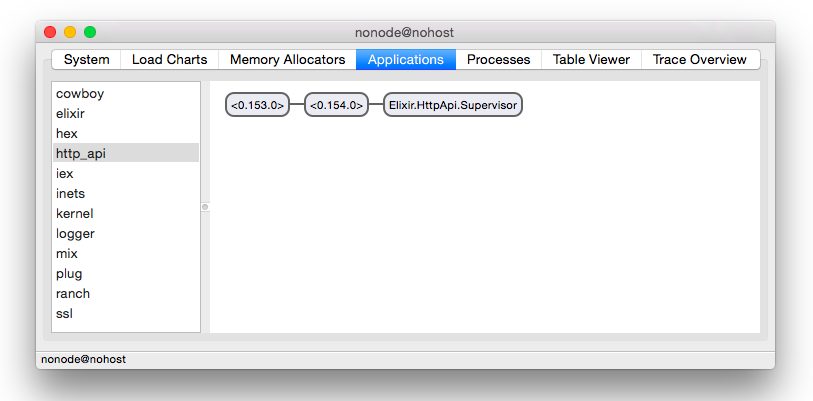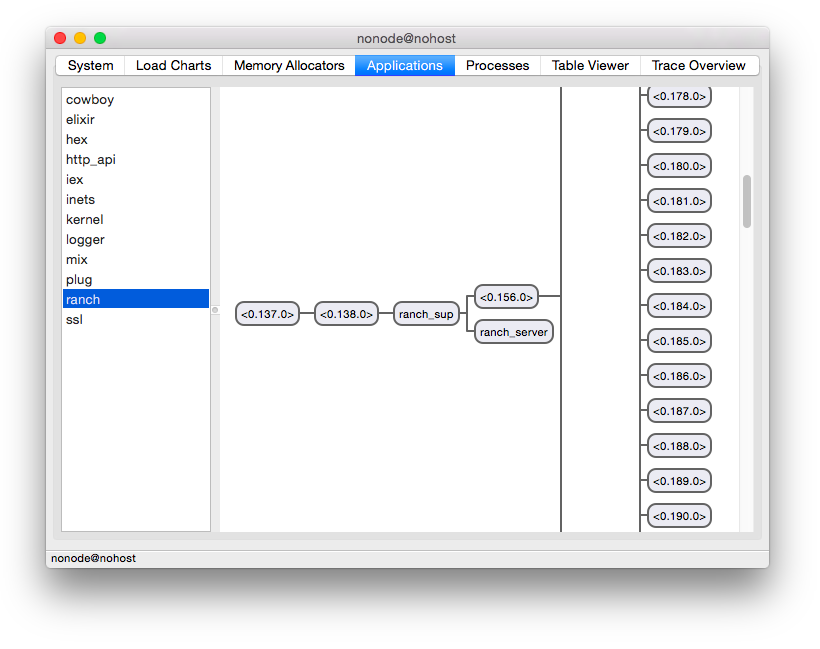Visualizing Parallel Requests in Elixir
by Emil Soman,
We have been evaluating Elixir at Codemancers and today I was learning how to spin up a minimal HTTP API endpoint using Elixir. Like Rack in Ruby land, Elixir comes with Plug, a swiss army knife for dealing with HTTP connections.
Using Plug to build an HTTP endpoint
First, let's create a new Elixir project:
$ mix new http_api --sup
This creates a new Elixir OTP app. Let's add :cowboy and :plug as
hex and application dependencies:
# Change the following parts in mix.exs
def application do
[applications: [:logger, :cowboy, :plug],
mod: {HttpApi, []}]
end
defp deps do
[
{:cowboy, "~>1.0.4"},
{:plug, "~>1.1.0"}
]
end
Plug comes with a router which we can use to build HTTP endpoints with ease. Let's create a module to encapsulate the router:
# lib/http_api/router.ex
defmodule HttpApi.Router do
use Plug.Router
plug :match
plug :dispatch
get "/" do
send_resp(conn, 200, "Hello Plug!")
end
match _ do
send_resp(conn, 404, "Nothing here")
end
end
If you have worked with sinatra-like frameworks, this should look familiar to you. You can read the router docs to understand what everything does if you are curious.
To start the server, we'll tell the application supervisor to start the Plug's Cowboy adapter:
# lib/http_api.ex
defmodule HttpApi do
use Application
def start(_type, _args) do
import Supervisor.Spec, warn: false
children = [
# `start_server` function is used to spawn the worker process
worker(__MODULE__, [], function: :start_server)
]
opts = [strategy: :one_for_one, name: HttpApi.Supervisor]
Supervisor.start_link(children, opts)
end
# Start Cowboy server and use our router
def start_server do
{ :ok, _ } = Plug.Adapters.Cowboy.http HttpApi.Router, []
end
end
The complete code for the above example can be found here. You can run the server using:
$ iex -S mix
This starts the interactive Elixir shell and runs your application on the Erlang VM. Now comes the fun part.
Visualizing processes using :observer
In the iex prompt, start the Erlang :observer tool using this command:
iex> :observer.start
This opens a GUI tool that looks like this:

On the left hand side of the Applications panel, you can see a list of all the applications currently running on the Erlang VM - this includes our app (http_api) and all its dependencies, the important ones being cowboy and ranch.
Cowboy and Ranch
Cowboy is a popular HTTP server in the Erlang world and it uses Ranch , another Erlang library, to handle TCP connections behind the scenes. When we start the Plug router, we pass on the router module to Plug's Cowboy adapter. Now when Cowboy receives a connection, it passes it over to Plug, and Plug runs it through it's plug pipeline and sends back the request.
Concurrent Requests
Plug by default asks cowboy to start 100 TCP connection acceptor processes in Ranch. You can see the 100 acceptor processes for yourself if you see the application graph of ranch using :observer.

Does this mean that we can only have 100 concurrent connections? Let's find out. We'll change the number of acceptors to 2 by passing it as a parameter to Plug's Cowboy adapter:
Plug.Adapters.Cowboy.http HttpApi.Router, [], [acceptors: 2]
Let's see the how the processes look like now:

Okay, so we've got only 2 TCP connection acceptor processes running. Let's try making 5 long running concurrent requests and see what happens.
# lib/http_api/router.ex
# Modify router to add some sleep
defmodule HttpApi.Router do
use Plug.Router
plug :match
plug :dispatch
# Sleep for 100 seconds before sending the reponse
get "/" do
:timer.sleep(100000)
send_resp(conn, 200, "Hello Plug!")
end
match _ do
send_resp(conn, 404, "Nothing here")
end
end
Let's make 5 requests now by running this in the iex prompt:
for n <- 1..5, do: spawn(fn -> :httpc.request('http://localhost:4000') end)
Start :observer from iex using :observer.start and see the process graph:

We can see that there are only 2 acceptor processes still, but 5 other processes were spawned somewhere else. These are connection processes which hold accepted connections. What this means is that, acceptor processes do not dictate how many processes we can run at a time, it just restricts how many new processes can be accepted at a time. Even if you want to serve 1000 concurrent requests, it's safe to leave the number of acceptor processes at the default value of 100.
Summary
- You can build simple HTTP endpoints using Plug router
- Ranch can handle multiple TCP connections at a time by spawning processes
- Erlang
:observeris a great way to visualize concurrency in your apps - Acceptor processes only accept connections. You only need 100 of them.